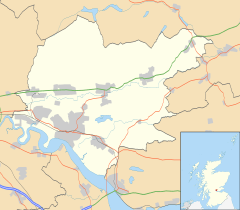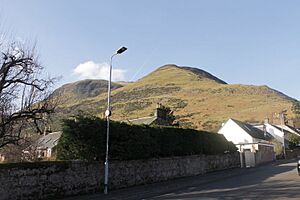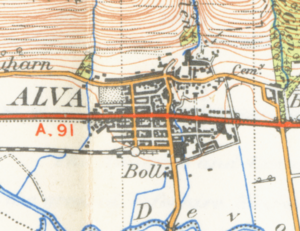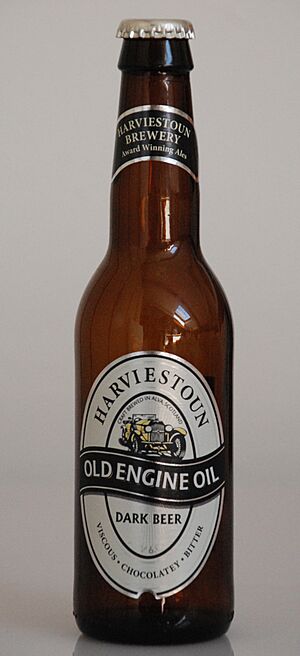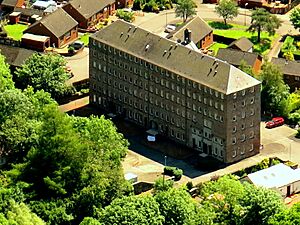Alva, Clackmannanshire facts for kids
Quick facts for kids Alva
|
|
|---|---|
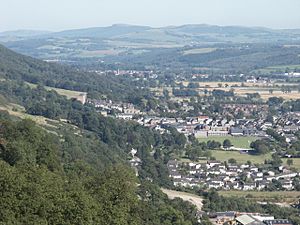 A view of Alva from Myreton Hill, facing east. |
|
| Area | 0.598 sq mi (1.55 km2) |
| Population | 4,630 (2020) |
| • Density | 7,742/sq mi (2,989/km2) |
| OS grid reference | NS882970 |
| Council area | |
| Lieutenancy area | |
| Country | Scotland |
| Sovereign state | United Kingdom |
| Post town | ALVA |
| Postcode district | FK12 |
| Dialling code | 01259 |
| Police | Central Scotland |
| Fire | Central Scotland |
| Ambulance | Scottish |
| EU Parliament | Scotland |
| UK Parliament |
|
| Scottish Parliament | |
Alva is a small town in Clackmannanshire, Scotland. It is found in the Central Lowlands part of the country. The name Alva comes from the Scottish Gaelic word Ailbheach, which means "rocky".
Alva is one of several towns located at the bottom of the Ochil Hills. These towns are often called the Hillfoots Villages. You can find Alva between the towns of Tillicoultry and Menstrie. In 2016, about 4,600 people lived in Alva. The town has a park with an event hall and an outdoor gym. It is also home to Alva Academy, a local secondary school.
Contents
What Does the Name Alva Mean?
The name Alva has changed over time. It was once known as Alueth, and then Alvath or Alveth. Most people believe the name comes from the Scottish Gaelic word Ailbheach. This word means "rocky," which makes sense given the area's landscape.
A Look Back: Alva's History
The old part of Alva grew up around Alva House. This was a large tower house built in 1542. It was made bigger and changed in 1636 by Sir Charles Erskine. The Erskine family owned Alva House until after 1802. Then, a mill owner named James Johnstone took it over. During the Second World War, the government used Alva House.
During the time of the Industrial Revolution, Alva became a big centre for making textiles. The woollen mills used water power at first. They gave jobs to many local people and those who moved to the area.
The old Mill Trail Centre was next to Cochrane Park. It was in the old Glentana Mill, built in 1887. This centre showed how the wool industry worked. It also shared stories of the many people who worked there. The Dalmore Works was built in 1874 by Wilson Brothers. They made things like tweed, wool fabrics, and rugs. Wilsons ran the works until 1964.
Alva used to be a separate part of Stirlingshire. But in 1891, it became part of Clackmannanshire.
Alva's Geography and Landscape
Alva is located right at the bottom of the Ochil Hills. A natural break in the earth, called the Ochil Fault, runs along the base of these hills. The ground under the flat land here is made of rocks from the Carboniferous period. The main hill that stands over the town is called Tory. Next to it on the west is Craigleith.
The town itself sits a bit higher than the flat land around it. It is built on two areas of soil and rock left by the Carnaughton Glen and Alva Glen burns. The amazing Alva Glen is a deep valley that cuts into the Ochil Hills just north of the town. The Alva Burn flows from this glen, through Alva, and into the River Devon.
East of Alva Glen is the Silver Glen. Silver was once mined here. A more recent attempt to mine coal, the Glenochil Colliery, was not successful. That site is now HM Prison Glenochil.
What Can You Find in Alva?
Alva has many shops for its residents. There are also three Christian places of worship. These include a Baptist church, a Church of Scotland, and St. John Vianney's Roman Catholic Church. The town also has a few pubs, a small library, and a medical centre.
There are two large parks in Alva: Johnstone Park and Cochrane Park. Cochrane Park is home to the local hall, called Cochrane Hall. Every second Saturday in July, Johnstone Park hosts the Alva Games. This is the last remaining Highland Games event in Clackmannanshire. The McArthur Braes, at the start of Alva Glen, was once a formal park. It is now being brought back to life.
Alva has both a primary school and a secondary school. Alva Academy is the secondary school. It takes students from several primary schools in the Hillfoots area. The school moved to a new campus in early 2009. The new Alva Academy is located at the end of Greenhead street, on the south-east side of town.
Getting Around: Transport in Alva
Alva is located on the main A91 road. This road connects Stirling to St Andrews. Bus services run from Alva to Stirling and to Alloa. Buses also go to St Andrews, but less often.
Alva once had a railway station. It served the town from 1863 until 1954.
Fun Things to Do: Recreation
In 1856, a special gathering was held in a park for gymnastics. This event grew and became the annual Alva Games.
Between 1937 and 1954, Alva Glen was famous for its yearly Illuminations. These were lights and displays that brought visitors from all over Scotland. In 2004, the Illuminations were brought back.
Alva's Economy and Businesses
Harviestoun Brewery
Harviestoun is a small Scottish brewery. It was started in 1983 by Ken Brooker. It began in an old stone barn on a farm near Dollar. In 2004, the brewery moved to the Alva Industrial Estate in Alva.
In 2006, Caledonian Brewery bought Harviestoun. But in 2008, Harviestoun became independent again. This happened when Caledonian was bought by Scottish & Newcastle. Sandy Orr and Donald MacDonald saw Harviestoun as a valuable business. They decided to buy the brewery and run it on its own.
Harviestoun Brewery makes many different kinds of beers. These include Schiehallion Craft Lager, Bitter & Twisted Golden Ale, and Old Engine Oil Black Ale. They also make Ola Dubh Whisky Barrel Aged Ale.
Buildings: Architecture
The most noticeable building in Alva is Strude Mill. This used to be a woollen mill. It has been fixed up and turned into flats. It stands above the town at the bottom of the hills. You can see it clearly from far away.
Famous People from Alva
- John Eadie (1810–1876) – He was a leader of the United Presbyterian Church of Scotland.
- Robert Erskine (physician) (1677–1718) – He was a doctor for Tsar Peter the Great in Russia. He helped improve the Russian medical service. He also started botanic gardens in Moscow and St Petersburg.
See also
 In Spanish: Alva (Escocia) para niños
In Spanish: Alva (Escocia) para niños


